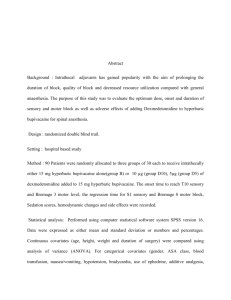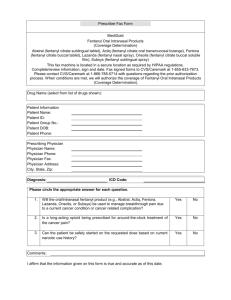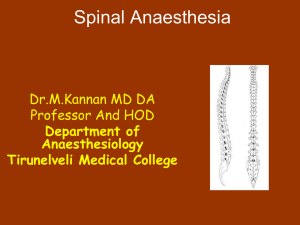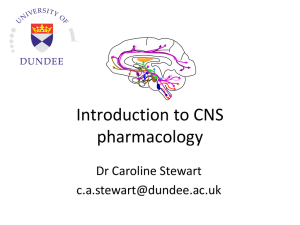a comparative study of intrathecal dexmedetomidine and fentanyl as
advertisement
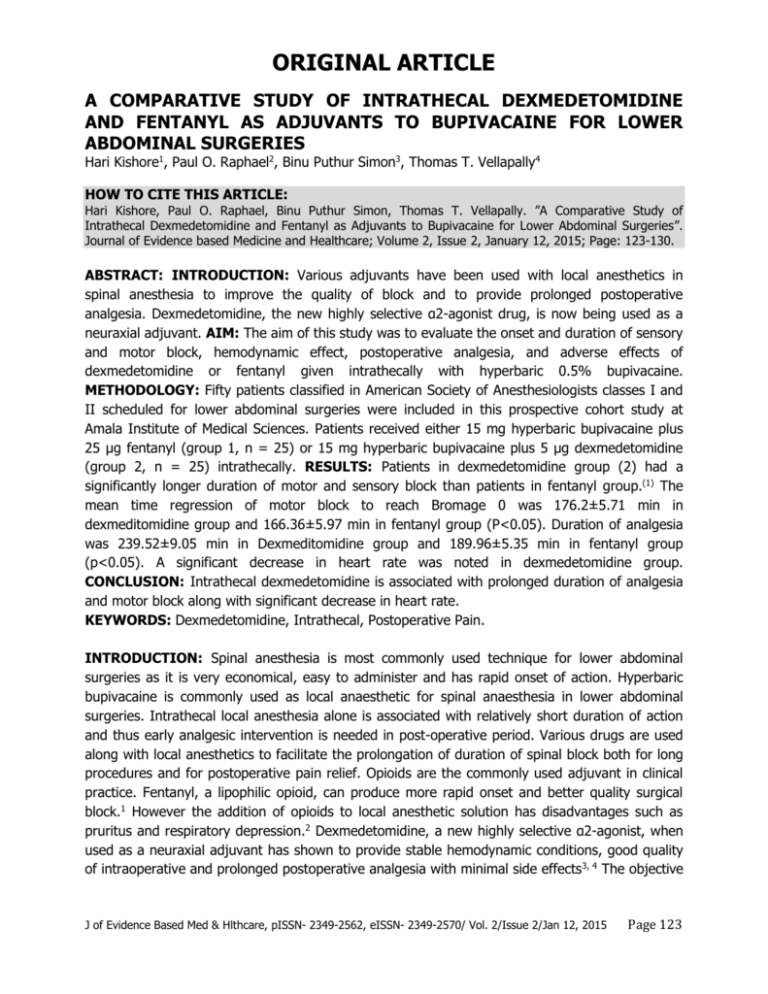
ORIGINAL ARTICLE A COMPARATIVE STUDY OF INTRATHECAL DEXMEDETOMIDINE AND FENTANYL AS ADJUVANTS TO BUPIVACAINE FOR LOWER ABDOMINAL SURGERIES Hari Kishore1, Paul O. Raphael2, Binu Puthur Simon3, Thomas T. Vellapally4 HOW TO CITE THIS ARTICLE: Hari Kishore, Paul O. Raphael, Binu Puthur Simon, Thomas T. Vellapally. ”A Comparative Study of Intrathecal Dexmedetomidine and Fentanyl as Adjuvants to Bupivacaine for Lower Abdominal Surgeries”. Journal of Evidence based Medicine and Healthcare; Volume 2, Issue 2, January 12, 2015; Page: 123-130. ABSTRACT: INTRODUCTION: Various adjuvants have been used with local anesthetics in spinal anesthesia to improve the quality of block and to provide prolonged postoperative analgesia. Dexmedetomidine, the new highly selective α2-agonist drug, is now being used as a neuraxial adjuvant. AIM: The aim of this study was to evaluate the onset and duration of sensory and motor block, hemodynamic effect, postoperative analgesia, and adverse effects of dexmedetomidine or fentanyl given intrathecally with hyperbaric 0.5% bupivacaine. METHODOLOGY: Fifty patients classified in American Society of Anesthesiologists classes I and II scheduled for lower abdominal surgeries were included in this prospective cohort study at Amala Institute of Medical Sciences. Patients received either 15 mg hyperbaric bupivacaine plus 25 μg fentanyl (group 1, n = 25) or 15 mg hyperbaric bupivacaine plus 5 μg dexmedetomidine (group 2, n = 25) intrathecally. RESULTS: Patients in dexmedetomidine group (2) had a significantly longer duration of motor and sensory block than patients in fentanyl group.(1) The mean time regression of motor block to reach Bromage 0 was 176.2±5.71 min in dexmeditomidine group and 166.36±5.97 min in fentanyl group (P<0.05). Duration of analgesia was 239.52±9.05 min in Dexmeditomidine group and 189.96±5.35 min in fentanyl group (p<0.05). A significant decrease in heart rate was noted in dexmedetomidine group. CONCLUSION: Intrathecal dexmedetomidine is associated with prolonged duration of analgesia and motor block along with significant decrease in heart rate. KEYWORDS: Dexmedetomidine, Intrathecal, Postoperative Pain. INTRODUCTION: Spinal anesthesia is most commonly used technique for lower abdominal surgeries as it is very economical, easy to administer and has rapid onset of action. Hyperbaric bupivacaine is commonly used as local anaesthetic for spinal anaesthesia in lower abdominal surgeries. Intrathecal local anesthesia alone is associated with relatively short duration of action and thus early analgesic intervention is needed in post-operative period. Various drugs are used along with local anesthetics to facilitate the prolongation of duration of spinal block both for long procedures and for postoperative pain relief. Opioids are the commonly used adjuvant in clinical practice. Fentanyl, a lipophilic opioid, can produce more rapid onset and better quality surgical block.1 However the addition of opioids to local anesthetic solution has disadvantages such as pruritus and respiratory depression.2 Dexmedetomidine, a new highly selective α2-agonist, when used as a neuraxial adjuvant has shown to provide stable hemodynamic conditions, good quality of intraoperative and prolonged postoperative analgesia with minimal side effects3, 4 The objective J of Evidence Based Med & Hlthcare, pISSN- 2349-2562, eISSN- 2349-2570/ Vol. 2/Issue 2/Jan 12, 2015 Page 123 ORIGINAL ARTICLE of this study was to compare the safety and analgesic efficacy of intrathecally administered dexmedetomidine with fentanyl in patients undergoing lower abdominal surgery. METHODS: Following approval of the institutional ethics committee, 50 ASA I and II female patients of ages between 30 to 60 years scheduled for abdominal hysterectomies via Pfannenesteil abdominal wall incision under spinal anaesthesia were included in this study. Patients with known allergy to any of the study medications, receiving medical therapies producing tolerance to opioids, with coagulopathy, psychiatric problems were excluded. Study protocol was explained to the patients and written informed consent was obtained from all the participants during pre-anesthetic evaluation. They were familiarized with visual analogue scale (VAS) and its use for measuring the postoperative pain. In the operation theatre electrocardiogram (ECG), pulse oximetry, and noninvasive blood pressure were attached and baseline parameters were recorded and monitoring was initiated. Intravenous (IV) access was secured and all patients were preloaded with ringer lactate 10 ml/kg. The first 25 consecutive patients satisfying the inclusion criteria and who received intrathecal 0.5% hyperbaric bupivacaine 15mg+5 mcg dexmedetomidine formed the group D. The first 20 consecutive patients satisfying the inclusion criteria received intrathecal 0.5% hyperbaric bupivacaine 15mg+25 mcg fentanyl and formed group F. All patients received a standard spinal anesthesia with 0.5% bupivacaine, (heavy) in the lateral position. No prophylactic antiemetics were given. A qualified anesthesiologist managing the case induced subarachnoid block at L3-4 or L4-5 vertebral level using 25-gauge Quincke spinal needle with patients in the lateral decubitus position under all aseptic precautions. Following free flow of CSF, drugs were injected slowly. Patients were positioned supine immediately after the administration of intrathecal agents. Level of sensory blockade checked using cold stimulus. Highest level of sensory blockade, the time of onset of sensory block and duration of sensory block were recorded. Time of onset of motor block, degree of motor block and duration of motor block were recorded using modified Bromage scale.5 Bromage Bromage Bromage Bromage 0: 1: 2: 3: the the the the patient patient patient patient is is is is able to move the hip, knee and ankle. unable to move the hip, but is able to move the knee and ankle. unable to move the hip and knee, but is able to move the ankle. unable to move the hip, knee and ankle. Duration of analgesia was recorded using Visual analogue scale. A score of 0 refers to no pain and 10 correspond to the most severe pain. Rescue analgesic (IM Tramadol 2mg/kg) was given when the patients began to experience nagging, uncomfortable pain (VAS≥ 4). Hemodynamic changes were also monitored at regular intervals. Systolic blood pressure (SBP), diastolic blood pressure (DBP), and heart rate (HR) were recorded every 1 min up to 5 min and then every 5 min up to 90 mins irrespective of the duration of surgery. Hypotension, defined as SBP <90 mm Hg or >30% fall from the baseline value was treated by injection ephedrine 6 mg (i.v) and crystalloid blouses. Bradycardia was defined as HR <50 beats/min or >30% decrease from the baseline value and was treated with i.v atropine 0.6 mg increments. J of Evidence Based Med & Hlthcare, pISSN- 2349-2562, eISSN- 2349-2570/ Vol. 2/Issue 2/Jan 12, 2015 Page 124 ORIGINAL ARTICLE Side effects and complications were also noted. Postoperatively sensory block, motor block and VAS scores were recorded in the post-anesthetic care unit every 10 minutes. The primary outcome of the study was to assess which group produced a longer duration of analgesia measured in terms of the first request for analgesia post operatively. The secondary outcome was to compare the two groups in terms of time of onset of analgesia (T10 block level assessed by cold stimulus), peak sensory level, onset of motor blockade (defined as modified Bromage Grade 3), degree of motor blockade (modified Bromage grade) and hemodynamic profile of the two groups. STATISTICAL ANALYSIS: All data was collected and coded, and entered in Microsoft Excel sheet and analyzed using appropriate statistical software. The onset and duration of sensory and motor blockade was measured in terms of mean deviation +/- standard deviation. The groups were compared using Students t – test. A p value of ≤0.05 was considered significant. Analysis was done using SPSS software. RESULTS: The demographic profile, which included patients age, weight, duration of surgery and ASA grading were similar and no significant difference was observed between the groups [Table 1]. There was no significant difference in the trend of systolic blood pressure, diastolic blood pressure or oxygen saturation (SpO2) among both groups. But there was significant decrease in heart rate in dexmedetomidine group compared to fentanyl group. The mean heart rate obtained at various intervals of time was significantly lower in dexmedetomidine group with a p value of <0.05. GROUP F GROUP D p- value (n= 25) (n= 25) AGE (years) 45.2 ± 5.49 45.44 ± 5.32 0.876 WEIGHT (kg) 57.92 ± 3.94 57.80 ± 4.60 0.922 DURATION OF SURGERY (minutes) 112.80 ± 8.77 112.56 ± 10.06 0.929 ASA Grade I/II 20/5 19/6 TABLE I The mean onset time of sensory block in fentanyl group was 3.72±0 .73 minutes and that of dexmedetomidine group was 3.40 ± 0.57 minutes. p=0.094. The mean onset time of modified Bromage 3 motor block was also not different among the groups 7.44±0.96 minutes in fentanyl group and 7.72±1.51 minutes in dexmedetomidine group p= 0.439. The regression time to reach modified Bromage 0 in Group D (176.72±5.71min) was significantly longer than that for group F (166.36±5.97 min.), p<0.001. The time to reach S1 segment was significantly longer in group D (192.72±6.61 min.) than in group F (177.96±5.01 min.) (P<0.001). J of Evidence Based Med & Hlthcare, pISSN- 2349-2562, eISSN- 2349-2570/ Vol. 2/Issue 2/Jan 12, 2015 Page 125 ORIGINAL ARTICLE GROUP FENTANYL GROUP DEXMEDETOMIDINE p - value (n = 25) (n = 25) DURATION OF SENSORY BLOCK (min) DURATION OF MOTOR BLOCK (min) 177.96 ± 5.01 192.72 ± 6.61 .0001 166.36 ± 5.97 176.72 ± 5.71 .0001 Table II FIGURE 1 FIGURE 2 J of Evidence Based Med & Hlthcare, pISSN- 2349-2562, eISSN- 2349-2570/ Vol. 2/Issue 2/Jan 12, 2015 Page 126 ORIGINAL ARTICLE Peak sensory level attained was T5 for 2 cases and T6 for 22 cases in dexmedetomidine group whereas fentanyl group had peak sensory level of T6 for 23 cases and T5 for 2 cases without significant difference between the groups. p=1.000. The mean VAS scores showed a significant increase in duration of analgesia in dexmedetomidine group 239.52±9.05 minutes compared to fentanyl group 189.96±5.35 mins p=0.001 mins. FIGURE 3 Hypotension occurred in both groups but the difference was not significant. 5 patients in dexmedetomidine group developed hypotension compared to 4 patients in fentanyl group. 2 patients in dexmedetomidine group were given Atropine injection following bradycardia compared to 0 patients in fentanyl group. There were no complications, such as nausea, vomiting, shivering, itching, pruritus and respiratory depression in patients of either group. DISCUSSION: In the present study, we assessed 50 patients aged 18 to 60 years belonging to ASA class I and II, posted for abdominal hysterectomy under spinal anesthesia. The results of our study show that supplementation of spinal bupivacaine with 5 µg dexmedetomidine significantly prolonged both sensory and motor block compared with intrathecal 25 µg fentanyl. Time of onset of sensory block and motor block was similar in both the D and F groups. These findings were in concordance with the results of Al Ghanem et al6 and Rajni Gupta7 who observed no difference in the onset time in patients receiving dexmedetomidine and fentanyl as adjuvants to isobaric bupivacaine. Al Mustafa et al3 compared the doses of dexmedetomidine 5, 10µg with intrathecal bupivacaine and found the effect to be dose dependent on the onset and regression of sensory and motor block . But the prolongation of the duration of spinal analgesia produced by intrathecal fentanyl is not dose related.8, 9 In non-obstetric patients studies demonstrated that a dose of 25 μg fentanyl for supplementation of spinal anesthesia produces excellent quality of perioperative J of Evidence Based Med & Hlthcare, pISSN- 2349-2562, eISSN- 2349-2570/ Vol. 2/Issue 2/Jan 12, 2015 Page 127 ORIGINAL ARTICLE analgesia.10, 11, 12 Based on the above study findings, fentanyl in a dose of 25μg was used for supplementation of spinal bupivacaine in the present study. Clonidine a α2 receptor agonist has been extensively studied for its use as an adjuvant in spinal anaesthesia.13, 14 Clonidine is used intrathecally at a dose range of 15 -150 µg as an adjuvant to local anaesthetic agents. Kanazi et al4 found that new α2 agonist dexmedetomidine in a dose of 3 µg is comparable to clonidine 30 μg as an adjuvant with spinal bupivacaine and both produced the same duration of sensory and motor block with minimal side effects in urologic surgical patients. In this context we assumed that 3-5 μg dexmedetomidine would be appropriate for supplementation of spinal bupivacaine intrathecally. The intrathecal 5mcg dexmedetomidine used in our study had shown prolonged duration of sensory block. Result was similar to many previous studies comparing these two drugs.6, 7, 8 Our results showed a significant prolongation in duration of analgesia assessed by VAS score. Studies by Rajni Gupta et al7 and Al Ghanem et al had showed similar results with dexmedetomidine. Apart from its antinociceptive actions for both somatic and visceral pain, dexmedetomidine when combined with spinal bupivacaine prolongs the sensory block by depressing the release of C fibre transmitters and by hyperpolarisation of post synaptic dorsal horn neurons.15, 16, 17 This explains the prolonged duration of analgesia noted with dexmedetomidine. In the present study there was a significant increase in the duration of motor block in patients of dexmedetomidine group. Motor block prolongation by α2-adrenoreceptor agonists may result from binding these agonists to motor neurons in the dorsal horn of the spinal cord.18 The most significant side effects reported about the use of intrathecal α2 adreno receptor agonists are bradycardia and hypotension. Hypotension following intrathecal injection of the drugs was comparable between the groups. Two patients in dexmedetomidine group had bradycardia, but it was successfully managed with IV atropine 0.6mg. Although there were no complications, such as vomiting, shivering, itching, pruritus and respiratory depression in patients of either group, three patients in both group complained of nausea in the recovery room. CONCLUSION: Intrathecal dexmedetomidine 5µg supplementation of spinal block is a good alternative to fentanyl 25 µg in major surgeries as it is associated with prolonged duration of analgesia but at the same time prolongs duration of motor block along with a significant decrease in heart rate. ACKNOWLEDGEMENT: We are grateful to the Department of social and preventive medicine, Amala institute of medical sciences, for their support in statistical analysis of data and Department of obstetrics and gynecology, Amala Institute of medical sciences, for facilitating the study. BIBLIOGRAPHY: 1. James P Rathmell, Timothy R Lair, Bushra Nauman. The Role of Intrathecal Drugs in the Treatment of Acute Pain. Anesth Analg 2005; 101: S30-43. J of Evidence Based Med & Hlthcare, pISSN- 2349-2562, eISSN- 2349-2570/ Vol. 2/Issue 2/Jan 12, 2015 Page 128 ORIGINAL ARTICLE 2. Hunt CO, Naulty JS, Bader AM, Hauch MA, Vartikar JV, Datta S, et al. Perioperative analgesia with subarachnoid fentanyl-bupivacaine for cesarean delivery. Anesthesiology. 1989; 71: 535–40. 3. Al-Mustafa MM, Abu-Halaweh SA, Aloweidi AS, Murshidi MM, Ammari BA, Awwad ZM, et al. Effect of dexmedetomidine added to spinal bupivacaine for urological procedure. Saudi Med J. 2009; 30: 365–70. 4. Kanazi GE, Aouad MT, Jabbour-Khoury SI, Al Jazzar MD, Alameddine MM, Al-Yaman R, et al. Effect of low-dose dexmedetomidine or clonidine on the characteristics of bupivacaine spinal block. Acta Anesthesiol Scand. 2006; 50: 222–7. 5. Bromage PR. A comparison of the hydrochloride and carbon dioxide salts of lidocaine and prilocaine in epidural analgesia. Acta Anaesthesiol Scand Suppl 1965; 16: 55-69. 6. Al Ghanem SM, Massad IM, Al Mustafa MM, Al Zaben KR, Qudaisat IY, Qatawneh AM, et al. Effect of adding dexmedetomidine versus fentanyl to intrathecal bupivacaine on spinal block characteristics in gynaecological procedures: A double blind controlled study. Am J Appl Sci 2009; 6: 882 7. 7. Gupta R, Bogra J, Verma R, Kohli M, Kushwaha JK, Kumar S. Dexmedetomidine as an intrathecal adjuvant for postoperative analgesia. Indian J Anaesth 2011; 55: 347-51. 8. Seewal R, Shende D, Kashyap L, Mohan V. Effect of addition of various doses of fentanyl intrathecally to 0.5% hyperbaric bupivacaine on perioperative analgesia and subarachnoid-block characteristics in lower abdominal surgery: a dose response study. Reg Anesth Pain Med.2007 Jan-Feb; 32(1): 20-6. 9. Kuusniemi KS, Pihlajamaki KK, Pitkanen MT, Helenius HY, Kirvela OA. The use of bupivacaine and fentanyl for spinal anesthesia for urologic surgery. Anesth Analg 2000; 91: 1452-1456. 10. Vaghadia H, McLeod DH, Mitchell GW, Merrick PM, Chilvers CR. Small-dose hypobaric lidocaine fentanyl spinal anesthesia for short duration outpatient laparoscopy.Optimal fentanyl dose.Anesth Analg 1997: 84: 65-70. 11. Liu S, Chiu AA, Carpenter RL, Mulroy MF, Allen HW, Neal JM, Pollock JE. Fentanyl prolongs lidocaine spinal anesthesia without prolonging recovery. Anesth Analg 1995: 80: 730-734. 12. Singh H, Ynag J, Thornton K, Giesecke AH.Intrathecal fentanyl prolongs sensory bupivacaine spinal block. Can J Anesth 1995: 42(11): 987-991. 13. Thakur A, Bhardwaj M, Kaur K, Dureja J, Hooda S, Taxak S. Intrathecal clonidine as an adjuvant to hyperbaric bupivacaine in patients undergoing inguinal herniorrhaphy: A randomized double-blinded study. J Anaesthesiol Clin Pharmacol 2013; 29: 66-70. 14. Sethi B S, Samuel M, Sreevastava D. Efficacy of Analgesic Effects of Low Dose Intrathecal Clonidine as Adjuvant to Bupivacaine. Indian J Anaesth 2007; 51: 415. 15. Eisanach JC, De Kock M, Klimscha W α2 adrenergic agonists for regional anesthesia. Anesthesiology 1996; 85: 655-674. 16. Lawhead RG, Blaxall HS, Bylund BD. Alpha-2A is the predominant α-2 adrenergic receptor subtype in human spinal cord. Anesthesiology 1992; 77: 983-991. J of Evidence Based Med & Hlthcare, pISSN- 2349-2562, eISSN- 2349-2570/ Vol. 2/Issue 2/Jan 12, 2015 Page 129 ORIGINAL ARTICLE 17. Smith SM, Schumbra UB, Wilson KH, Page SO, Hulette C, Light AR, Schwinn DA. Alpha 2 adrenergic receptor in human cord: Specific localized expression of mRNA encoding alpha2 adrenergic receptor subtypes at four distinct levels. Brain Res 1995; 34: 109-117. 18. Harada Y, Nishioka K, Kitahata LM, et al Visceral antinociceptive effects of spinal clonidine combined with morphine, enkephalin, or U50, 488H. Anesthesiology1995; 83: 344-52. AUTHORS: 1. Hari Kishore 2. Paul O. Raphael 3. Binu Puthur Simon 4. Thomas T. Vellapally PARTICULARS OF CONTRIBUTORS: 1. Professor, Department of Anaesthesiology, Amala Institute of Medical Sciences. 2. Associate Professor, Department of Anaesthesiology, Amala Institute of Medical Sciences. 3. Assistant Professor, Department of Anaesthesiology, Amala Institute of Medical Sciences. 4. Junior Registrar, Department of Anaesthesiology, Amala Institute of Medical Sciences. NAME ADDRESS EMAIL ID OF THE CORRESPONDING AUTHOR: Dr. Hari Kishore, Professor, Department of Anaesthesiology, Amala Institute of Medical Sciences. E-mail: dr.hkishore@gmail.com Date Date Date Date of of of of Submission: 24/12/2014. Peer Review: 26/12/2014. Acceptance: 06/01/2015. Publishing: 09/01/2015. J of Evidence Based Med & Hlthcare, pISSN- 2349-2562, eISSN- 2349-2570/ Vol. 2/Issue 2/Jan 12, 2015 Page 130
